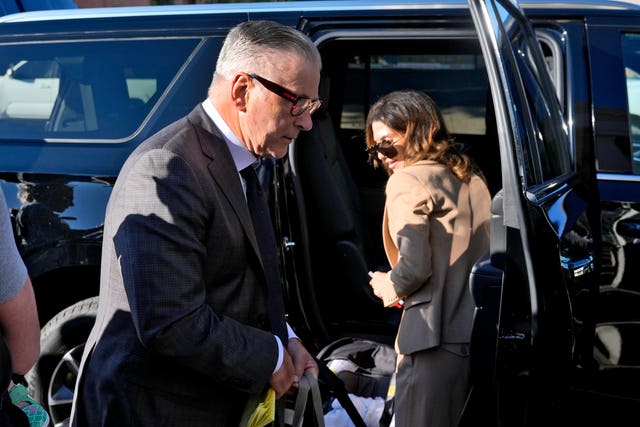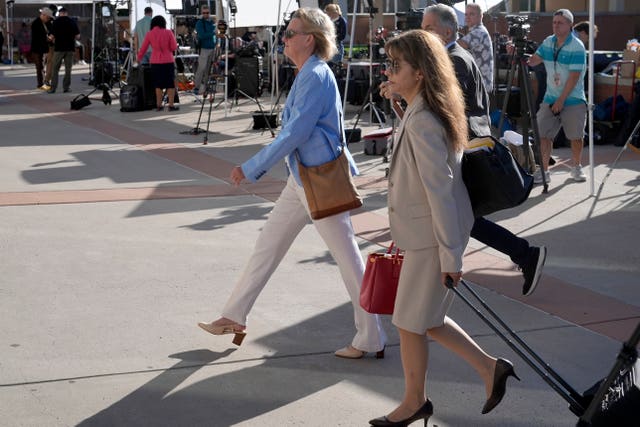Alec Baldwin trial over movie set shooting death begins with jury selection
The actor is accused of involuntary manslaughter over the killing of cinematographer Halyna Hutchins during the making of the western move Rust.

Alec Baldwin’s trial in the shooting of a cinematographer begins on Tuesday with the selection of jurors who will decide whether the actor is guilty of involuntary manslaughter.
Getting chosen to serve in a trial of such a major star accused of such a major crime would be unusual even in Los Angeles or Baldwin’s hometown of New York.
But it will be essentially an unheard-of experience for those who are picked as jurors in Santa Fe, New Mexico, though in recent years the state has increasingly become a hub of Hollywood production.
Baldwin and his wife, Hilaria, arrived at the courthouse on Tuesday with their youngest child, Ilaria Catalina Irena Baldwin. The couple have seven children, ranging in ages from one to 10.

The jurors are tasked with deciding whether Baldwin committed the felony when, during a rehearsal in October 2021, a revolver went off while he was pointing it at cinematographer Halyna Hutchins, killing her and wounding director Joel Souza.
They were on the set of the Western film Rust, at Bonanza Creek Ranch some 18 miles from where the trial is being held.
Baldwin has said the gun fired accidentally after he followed instructions to point it toward Ms Hutchins, who was behind the camera.

The star of 30 Rock and The Hunt for Red October made his first appearance in the courtroom on Monday, when Judge Mary Marlowe Sommer, in a significant victory for the defence, ruled at a pretrial hearing that Baldwin’s role as a co-producer on Rust is not relevant to the trial.
The judge has said that the special circumstances of a celebrity trial should not keep jury selection from moving quickly, and that opening statements should begin on Wednesday.
“I’m not worried about being able to pick a jury in one day,” Judge Marlowe Sommer said. “I think we’re going to pick a jury by the afternoon.”
Special prosecutor Kari Morrissey, however, was dubious that Baldwin’s lawyers, with whom she has clashed in the run-up to the trial, would make that possible.
“It is my guess that with this group of defence attorneys, that’s not gonna happen,” Ms Morrissey said at the hearing.
Baldwin lawyer Alex Spiro replied, “I’ve never not picked a jury in one day. I can’t imagine that this would be the first time.”
Dozens of prospective jurors were shuffled into the courtroom for questioning on Tuesday morning.
Notable attendees on Tuesday included Stephen Baldwin, The Usual Suspects actor. Cameras capturing the rest of the proceedings will be turned off to protect jurors’ privacy. The jury is expected to get the case after a nine-day trial.
Lawyers will be able to request to dismiss them for conflicts or other reasons. The defence under state law can dismiss up to five jurors without giving a reason, and the prosecution can dismiss three. More challenges will be allowed when four alternates are chosen.
Before Judge Marlowe Sommer’s ruling on Monday, prosecutors had hoped to highlight Baldwin’s safety obligations on the set as co-producer to bolster an alternative theory of guilt beyond his alleged negligent use of a firearm.
They aimed to link Baldwin’s behaviour to “total disregard or indifference for the safety of others” under the involuntary manslaughter law.
But the prosecution managed other wins on Monday. They successfully argued for the exclusion of summary findings from a state workplace safety investigation that placed much of the blame on the film’s assistant director, shifting fault away from Baldwin.
And the judge ruled that they could show graphic images from Ms Hutchins’ autopsy, and from police lapel cameras during the treatment of her injuries.





